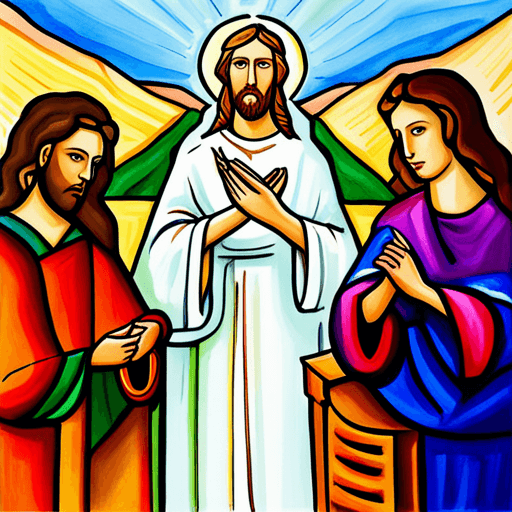You are a seeker of truth, someone who desires to understand the deeper layers of meaning in the words of scripture. You recognize that there is more to the Bible than just surface-level interpretations, that the stories and teachings hold a wealth of symbolic imagery and allegory waiting to be unlocked.
This is where the tradition of Catholic biblical interpretation comes in, with its rich history of using allegory to uncover hidden truths within scripture. For centuries, Catholic theologians have utilized allegorical interpretation as a way to delve deeper into the spiritual significance behind biblical texts.
By understanding the layers of meaning present in each passage, they were able to uncover hidden messages and insights that might otherwise go unnoticed. This approach recognizes that every word in scripture has been chosen with care and intentionality, and by exploring these symbols and metaphors, we can gain a clearer picture of God’s plan for humanity.
In this article, we will explore how allegory has been used throughout history in Catholic biblical interpretation, examine some examples of symbolic imagery found within scripture, and discuss how this approach can be applied today to contemporary issues facing our world.
The History of Allegorical Interpretation in Catholicism
Let’s dive into the fascinating history of how Catholics have approached interpreting the Bible through layers of deeper meaning.
Throughout the centuries, Catholic biblical interpretation has been heavily influenced by medieval scholars who believed that the Scriptures contained multiple levels of meaning. They saw allegory as a way to uncover these hidden truths and bring them to light for all believers to see.
However, this approach has faced its fair share of contemporary challenges. In recent times, many have criticized allegorical interpretation for being too subjective and lacking in historical accuracy. Some argue that it can be used to justify any interpretation one wishes, leading to a lack of consensus among believers.
Despite these criticisms, allegory remains an important tool in Catholic biblical interpretation and continues to inspire new insights into the Word of God.
Understanding the Layers of Meaning in Scripture
You’ll gain a richer understanding of Scripture by recognizing the multiple layers of meaning within its text. Catholic biblical interpretation involves more than just reading the Bible literally; it requires an appreciation for literary techniques and hermeneutical principles that allow you to delve deeper into the heart of God’s message.
One way to uncover these layers is through allegory, which involves interpreting a story or passage as having symbolic meaning beyond its literal sense. This approach allows you to see how different parts of Scripture connect with each other and reveal spiritual truths that may not be immediately apparent.
By opening yourself up to this broader perspective, you can gain insights into God’s character and his plan for humanity that will deepen your faith and enrich your relationship with Him.
Symbolic Imagery in the Bible
Get ready to uncover the hidden meaning behind the powerful symbolic imagery found throughout the Bible. The use of biblical metaphors and spiritual representations is a common practice in Catholic biblical interpretation. These symbols often carry multiple layers of meaning, allowing for a deeper understanding and connection to the text.
For example, the image of water is often used in scripture as a symbol for cleansing and renewal. This can be seen in baptismal imagery, such as when Jesus was baptized by John in the Jordan River. The water represents not just physical purification, but spiritual rebirth and transformation.
By understanding these symbolic images, we can connect more fully with the message of the scripture and find deeper meaning in our own lives.
The Role of Allegory in Catholic Theology
Understanding the deeper layers of meaning behind symbolic imagery in the Bible can enhance your appreciation and connection to Catholic theology. This is where allegory plays a crucial role.
Theological implications arise when we delve into the hidden meanings of scriptural texts, which are often obscure or veiled. In fact, early Church fathers like Origen and Augustine believed that Scripture had multiple levels of interpretation, with allegory being the highest level. They saw biblical stories as containing hidden truths that could only be uncovered by reading between the lines and connecting them to other parts of the Bible.
However, hermeneutical challenges also arise when using allegory in biblical interpretation, especially if one isn’t careful enough. It can lead to subjective interpretations that may stray from orthodox teachings or even contradict them altogether.
That’s why it’s important to use allegory responsibly and within certain parameters set by Catholic tradition and authoritative teachers. Done correctly though, it can deepen our understanding of God’s message for us and help us see how everything in creation is interconnected in profound ways beyond what meets the eye.
Applying Allegory to Contemporary Biblical Issues
By delving into the symbolic imagery of modern-day issues in Scripture, you can uncover deeper truths that are often overlooked. Modern applications of allegory allow us to see how God’s word is still relevant today.
For example, the parable of the Good Samaritan can be applied to contemporary issues like immigration and refugees. When we see ourselves as the Samaritan who helps someone in need regardless of their background, we’re reminded that loving our neighbor means showing compassion to those different from us.
Cultural relevance is also an important aspect of applying allegory to contemporary biblical issues. By understanding the cultural context of biblical stories, we can better understand how they apply to our lives today.
For instance, the story of Ruth and Naomi can teach us about loyalty and self-sacrifice in relationships. But it also addresses themes such as identity and migration that are still relevant today.
As Catholics interpreting Scripture through allegory, it’s important to look beyond surface-level meanings and consider how these stories speak to us in our current cultural climate.
Frequently Asked Questions
How does the use of allegory in Catholic interpretation compare to its use in other Christian denominations?
Are you curious about how the use of allegory in Catholic interpretation compares to other Christian denominations? Well, let’s take a journey through history and explore the roots of this practice.
In the early days of Christianity, allegorical interpretation was commonly used among scholars to uncover deeper meanings within biblical texts. However, as time passed, Protestantism emerged and with it came a shift towards literal interpretations of scripture.
This divergence in approach has resulted in differences between Catholic and Protestant interpretations of certain passages. Nevertheless, both methods have their merits and offer unique insights into the Word of God.
Are there any biblical passages that are particularly well-suited for allegorical interpretation in Catholicism?
Imagine yourself in a dense forest, surrounded by towering trees and winding paths. As you make your way through the wilderness, you come across a small stream that trickles over smooth stones.
It’s here that allegorical interpretation techniques can be particularly effective in Catholic exegesis. The stream can represent the flow of grace from God, while the stones symbolize obstacles on our spiritual journey.
By using these symbols to interpret biblical passages, we can gain deeper insights into our faith and find greater meaning in our lives as Catholics. The role of symbolism in Catholic exegesis can’t be overstated, as it allows us to connect with God and each other on a level that transcends mere words on a page.
So dive into the waters of allegory and let the current carry you towards a deeper understanding of your faith.
How has the Catholic Church’s approach to allegorical interpretation evolved over time?
Imagine yourself stepping back in time, centuries ago, when the Catholic Church was still in its early stages of development. Back then, the approach to allegorical interpretation was largely influenced by the historical context of the times and the teachings of prominent theologians.
Over time, however, as the Church evolved and grew stronger in its foundation and understanding of biblical texts, so too did its approach to allegorical interpretation. Today, we can see how this evolution has led to a more nuanced and sophisticated understanding of scripture, one that takes into account both literal and figurative elements.
Whether it’s through exploring deeper theological concepts or simply seeking a greater sense of belonging within the larger church community, there’s no denying that this ongoing evolution has played an important role in shaping Catholicism’s outlook on biblical interpretation over time.
Are there any potential pitfalls or dangers associated with relying too heavily on allegory in biblical interpretation?
When interpreting the Bible, it’s important to be mindful of the potential dangers associated with relying too heavily on allegory. Although it can offer a unique and insightful perspective, overreliance on allegory may lead to overlooking the literal meaning of the text or even distorting its intended message.
Moreover, theological implications may arise when interpreting scripture through an overly subjective lens. It’s crucial to approach biblical interpretation with balance and discernment, taking into account both the historical context and literary genre of each passage.
By doing so, we can gain a deeper understanding of God’s word while avoiding the pitfalls that come with excessive allegorical interpretation.
How do modern Catholic scholars and theologians approach the use of allegory in interpreting scripture?
As a modern Catholic seeking to understand the Bible, you must consider not only the text itself, but also the context in which it was written and how interpretive methods have evolved since then.
Historical context is essential in understanding the meaning of scripture, and modern scholars and theologians recognize that allegory can be a useful tool when used correctly. However, they approach its use with caution, recognizing the potential dangers of relying too heavily on symbolic interpretations.
Instead, they strive for a balance between literal and figurative meanings in order to fully grasp the richness and complexity of God’s message to humanity.
By taking this approach, you can deepen your understanding of scripture while also avoiding any pitfalls associated with overreliance on allegory.
Conclusion
Congratulations! You’ve reached the end of this article on the use of allegory in Catholic biblical interpretation.
Throughout history, Catholics have used allegorical interpretation to understand the many layers of meaning within Scripture. From symbolic imagery to deeper theological implications, allegory has played a vital role in Catholic theology.
As you continue your own exploration of Scripture, consider how applying allegorical interpretations can help deepen your understanding and connection to God’s word. Just as each symbol and layer adds depth and richness to the story, each new perspective you gain through allegory can bring new insights and revelations into your own faith journey.
So go forth with an open heart and mind, ready to uncover the many treasures hidden within the pages of Scripture through the use of allegory. May it enrich your spiritual life and bring you closer to God.




